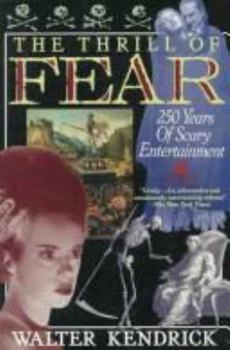Thrill of Fear: Two-Hundred and Fifty Years of Scary Entertainment
Select Format
Select Condition 
Book Overview
Why do we enjoy scaring ourselves? Why do some of the largest industries in the world--books, films, television, toys and games--depend so crucially on ghouls, ghosts and zombies? Walter Kendrick... This description may be from another edition of this product.
Format:Paperback
Language:English
ISBN:0802132464
ISBN13:9780802132468
Release Date:January 1992
Publisher:Grove/Atlantic
Length:292 Pages
Weight:1.05 lbs.
Dimensions:0.9" x 6.1" x 9.2"
Customer Reviews
3 ratings
The Roots of Fear
Published by Thriftbooks.com User , 14 years ago
I am somewhat fond of horror books and movies, but I am not what Walter Kendrick would call a "slasher maven". It's the old fashioned stuff stuff that I like: horror films from the thirties, traditional ghost stories, gothic novels, _Weird Tales_ anthologies. Like Kendrick, I believe that horror media contains the "occasional genius" (xxvi) but that it is mostly "infatuated collectors, mad self-dramatizers, scrambling hacks, stern remonstrators, fools, gulls, [and] lunatics" (_ibid_). It is not a field that has engendered many classics, but it has provided a certain amount of fun. _The Thrill of Fear: 250 Years of Scary Entertainment_ (1991) is a scholarly study that traces the roots of horror back to the mid-eighteenth century with the resurgence of Graveyard poetry (such as Gray's _Elegy_), sentimental romances (such as _The Sorrows of Young Werther_), the gothic novel (like Walpole's _Castle of Otranto_), melodramatic plays, and accounts of "true life crimes". In later years, horror fiction became more "Genrified" into _Weird Tales_ stories, pulp fiction, E.C. horror comics, and monster movies. In recent years, the horror industry has become more graphically violent with horror being the main emotion intended to be raised among the audience. (Earlier works of horror aimed for other emotions in addition to horror.) Kendrick argues that the violence may in fact recede over time. Kendrick notes several paradoxes relating to the roots of horror fiction. At a time when cemeteries were becoming more sanitary and modern, the public thought of them as gloomy and horrific sites with yew trees, owls, ravens, and crypts-- sites for murder or (at the very least) Dark Meditations on Mortality. Gothic castles totally unlike real medieval castles anchored themselves in the popular imagination. (They later evolved into Old Dark Houses.) Rotting bodies and faces were also popular. They had actually been around before in paintings and statuary. But before, they were _familiar_. Now, they were to be _feared_. Kendrick repeatedly uses the terms "horrible books" and "horrible movies". He claims that his reason is purely descriptive, that he does not want them confused with "gothic architecture". In this, I believe that Kendrick is being disingenuous. They are terms that invite ridicule. While much of horror fiction/movies is pretty awful stuff, I believe that Mary Shelly, J.S. Le Fanu, and M.R. James deserve higher accord than Kendrick gives them. Even lesser writers like W.W. Jacobs, F. Marion Crawford, and Robert Bloch were a bit more than miserable hacks grinding out potboilers. On the balance, though, this is an excellent and well-written study. It is a reminder that Stephen King and Ramsey Campbell had their predecessors-- and that they were not exactly like what we take for granted today.
The making of convention and cliche
Published by Thriftbooks.com User , 21 years ago
This book maps a history of horror through literature, theatre, and movies. From the obscure to the mainstream, the author shows the depth of his research. He refers to such work as "horrid" literature. After reading, I don't think he intends to disregard the tradition, but I think he is trying to maintain distance.The text follows a linear train of thought as it goes from the Graveyard Poets to more modern movies. As it progresses, the author continues to link how a particular book or film borrowed an element or two from a previous work. From this, all horror sounds formulaic and was stolen from some place else. This is misleading. Most works borrow from others. The thrill comes in mastering the elements or giving them a twist. I was disappointed that more was not said of H.P. Lovecraft, but that's just my wish.After reading this book, I feel that the same came be done for most genres. Every genre has particular conventions and cliches that are used to get a specific response from the reader. Crypts create a sense of terror. A quest means growth or coming of age. A sandy beach at sunset means romance is brewing. This is what makes a genre a genre.One of the benefits of the book is the bibliography. Any fan of horror, gothic or slasher, will learn of more books to read.I would not recommend the book for casual reading. I would recommend it if you are a horror enthusiast looking for new authors.
A triumph of modern criticism
Published by Thriftbooks.com User , 27 years ago
_The Thrill of Fear_ is the rarest of books -- a scholarly study that can be read and enjoyed by the layman. Covering 250 years of literature and art is an awesome task, but Kendrick attacks it with aplomb and pulls it off just as neatly as you please. This most entertaining book is highly reccommended to anyone with an interest in the horrid and the macabre -- from Gothic novels to EC comics to the gore-filled mayhem that passes for horror movies these days; it's all here!






